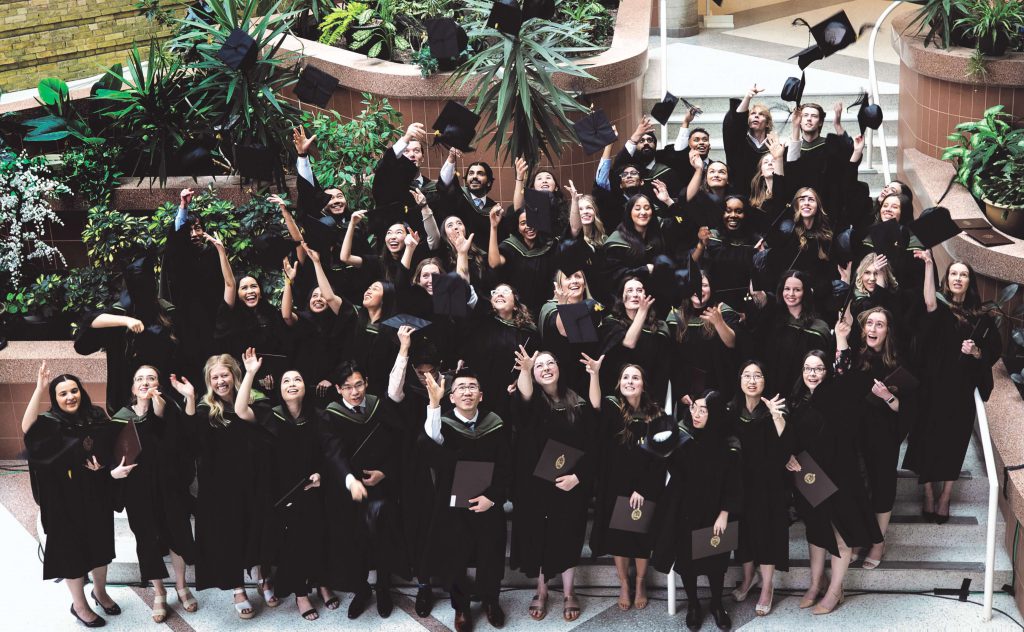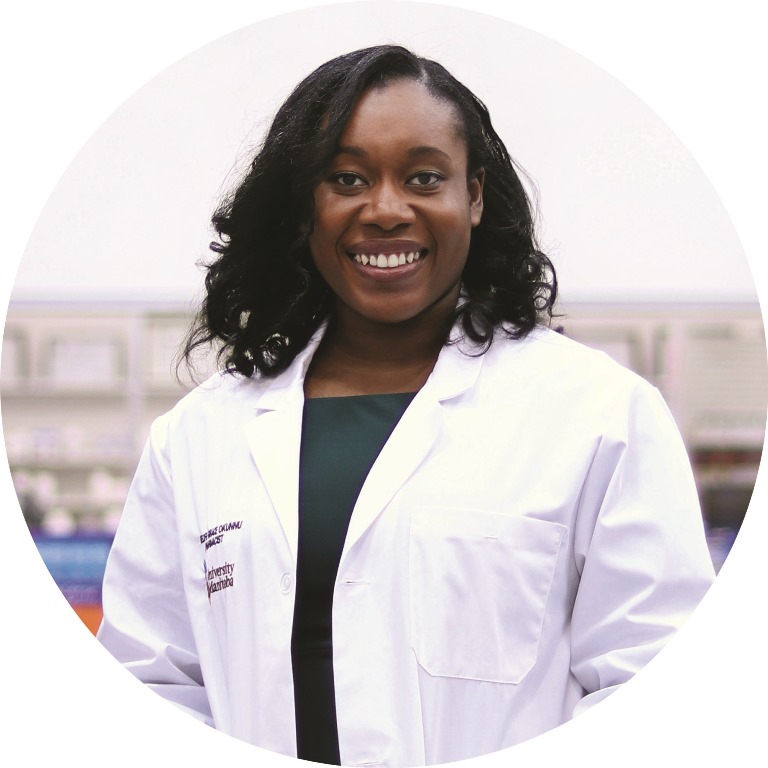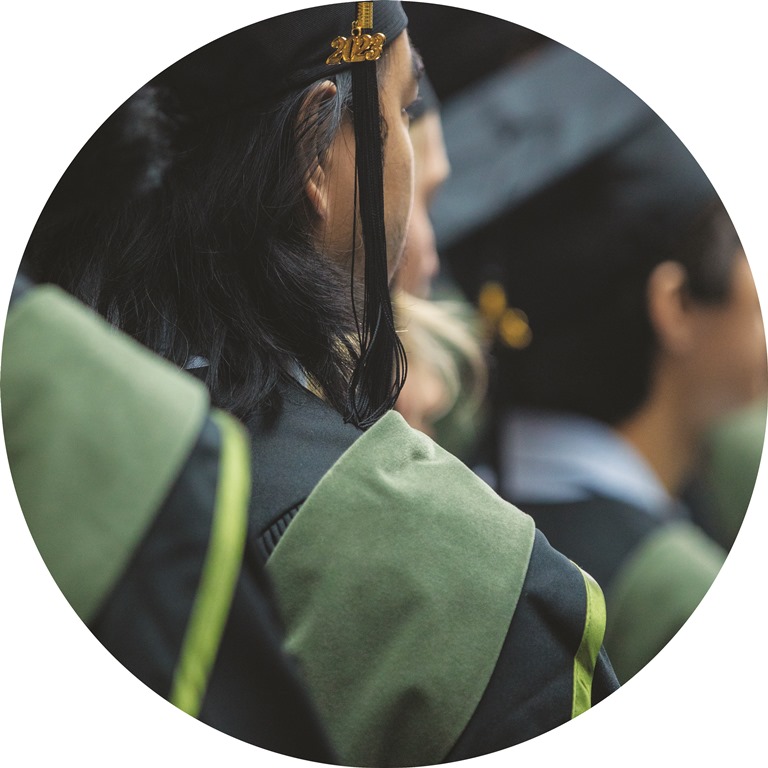
The first students to earn the new doctor of pharmacy (PharmD) undergraduate degree at UM jubilantly tossed their graduation caps in the air at Spring Convocation, marking a new era for pharmacy education in Manitoba.
The PharmD program, which has replaced UM’s long-standing bachelor of science (pharmacy), is a four-year professional degree program that focuses on clinical practice, experiential learning and pharmaceutical sciences.
The program now requires two years of university prerequisites for admission (versus the one year required previously). It packs in much more hands-on training and includes more than 40 newly revised or developed courses.
The inaugural PharmD class of 49 graduates followed a unique path. The students entered the College of Pharmacy in the fall of 2018, completed one year of the bachelor’s program, then transitioned to the new program for an additional four years of study.
“Your journey has been nothing short of extraordinary,” said Dr. Lalitha Raman-Wilms, dean of the College of Pharmacy, in her Convocation address on May 18. “You are a remarkable group of highly trained pharmacists who will help lead the profession to new heights.”
The change from the bachelor of science (pharmacy) to the PharmD degree as the entry-to-practice qualification for pharmacists was required by the Canadian Council for Accreditation of Pharmacy Programs. Most of Canada’s 11 pharmacy schools have completed the transition. The new degree reflects the fact that pharmacists’ role in patient care is expanding, said Dr. Lavern Vercaigne [B.Sc. Pharm/91], associate dean (academic).
In Manitoba, pharmacists’ scope of practice now includes services such as injecting vaccines, prescribing for uncomplicated urinary tract infections, ordering lab tests, prescribing for smoking cessation, prescribing medications within a collaborative practice, and providing a continued care prescription to extend medication for a chronic condition when the usual prescriber is unavailable.
“The scope of practice will continue to evolve,” Vercaigne said. “Pharmacists need the skills and knowledge to be more closely involved in patients’ health outcomes than ever before.”
The PharmD curriculum has expanded the breadth and depth of study in clinical and advanced therapeutics, scientific literature evaluation, pharmacogenetics, pharmacoepidemiology and pharmacoeconomics, as well as patient care-related practice skills laboratories, simulation training and Indigenous health.
The curriculum also includes an interprofessional component that prepares future pharmacists to work collaboratively with other health-care providers.
Raman-Wilms said the students showed commendable flexibility as the new program was rolled out.
“We’ve really worked in partnership, because it’s been new for them and new for us. They’ve helped shape the program as we learned the best ways to deliver it.”
While the previous program required 640 hours of in-the-field experience, the PharmD degree demands a greatly expanded 1,600 hours. The entire final year of study is now spent working with patients.
Twenty-five of the 92 experiential training sites were located outside Winnipeg, including in Churchill, Norway House and Beausejour, Man.
“Our fourth-year rotations gave us hands-on experience in the different practice settings of a pharmacist, such as community, primary care, hospital and research,” said Sabina Ozog [B.Sc./21, PharmD/23], winner of the University Gold Medal for the highest academic standing in the class.
Ozog plans to give back in the future by serving as a preceptor (a professional who supervises and mentors learners). “I’ve been fortunate to be trained by some truly exceptional preceptors,” she said. “I’m inspired by their passion and dedication towards teaching, and I hope to contribute to the profession in this way once I gain more practice experience.”
BY RADYUM STAFF

Prepared for Present and Future
Oreofe Grace Okunnu [B.Sc./18, PharmD/23], a member of the first class to earn the PharmD degree at UM, won the Passion and Commitment Award funded by the Pharmacy Class of 2009, recognizing her academic excellence and community service.
The PharmD program pushed her to reach her potential, said Okunnu, 25, who immigrated from Nigeria as a young child and grew up in Winnipeg.
“I learned how much capacity I had to grow and stretch.”
Because her sister completed the now-discontinued bachelor of science (pharmacy) at UM in 2018, Okunnu had some basis to compare the two programs. PharmD’s greater emphasis on experiential learning is the most pronounced change, she said.
“In the B.Sc. (Pharm) program, certain practice settings were only available as electives. In the PharmD program, community pharmacy, hospital pharmacy and primary care are all core rotations.”
In her fourth year, Okunnu gained experience in community pharmacy at a Walmart store, hospital pharmacy at Health Sciences Centre (HSC), primary care at the PRIME seniors’ program at Misericordia Health Centre, and did an elective rotation with a pharmacy tech company, MedEssist.
“The patients you encounter on rotations are not textbook cases,” she said. “They often have multiple health conditions, complex social situations and challenges with their medications. Rotations were a safe learning environment to gain experience in providing optimal patient-centred care.”
The PharmD program also includes a new requirement to complete a research project. “The exposure to formal research added greater dimension to my pharmacy education,” Okunnu said.
Now a staff pharmacist in the inpatient department at HSC, Okunnu believes the new UM program gave her a solid career foundation.
“The program has evolved to ensure graduates are prepared for both the present and future terrain of the profession. I feel prepared to ride the waves of change as pharmacy progresses.”

New Degree, New Regalia
Awarding the doctor of pharmacy (PharmD) degree for the first time called for a new ceremonial hood for grads to wear with their gowns at Convocation.
“We wanted to reflect the prestige and significance of the new degree,” said Cheryl Lee [B.H.Ecol./02], academic educational coordinator at the College of Pharmacy.
In the past, recipients of the bachelor of science (pharmacy) wore a hood adorned with a thin line of green trim and a band of white fur.
Lee worked with Dr. Lavern Vercaigne [B.Sc.Pharm/91], associate dean (academic), and Dr. Lalitha Raman-Wilms, dean of pharmacy, to plan the new hood’s design. They learned that many PharmD programs across North America use the colour olive green.
“The decision to adopt similar colours aligns the college with the broader PharmD community while preserving a unique UM identity,” Raman-Wilms said.
UM’s regalia supplier was asked to create a sample hood with khaki-coloured velvet trim and an olive satin lining.
The sample was displayed in the dean’s office so the college community could provide feedback. The response was overwhelmingly positive, and the hoods were christened by the inaugural PharmD class.
“It was a thrill to see the first grads line up in the distinctive new colours,” Lee said.
